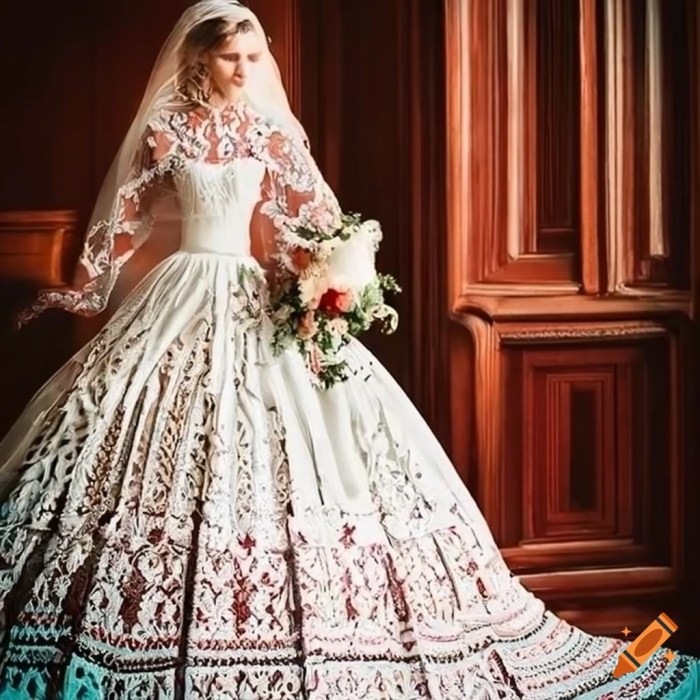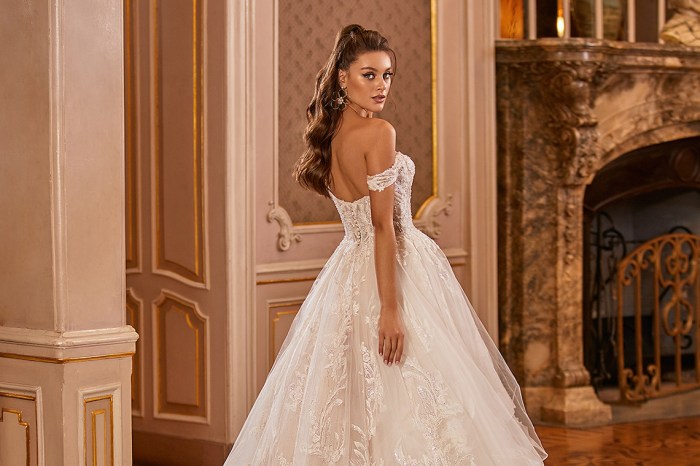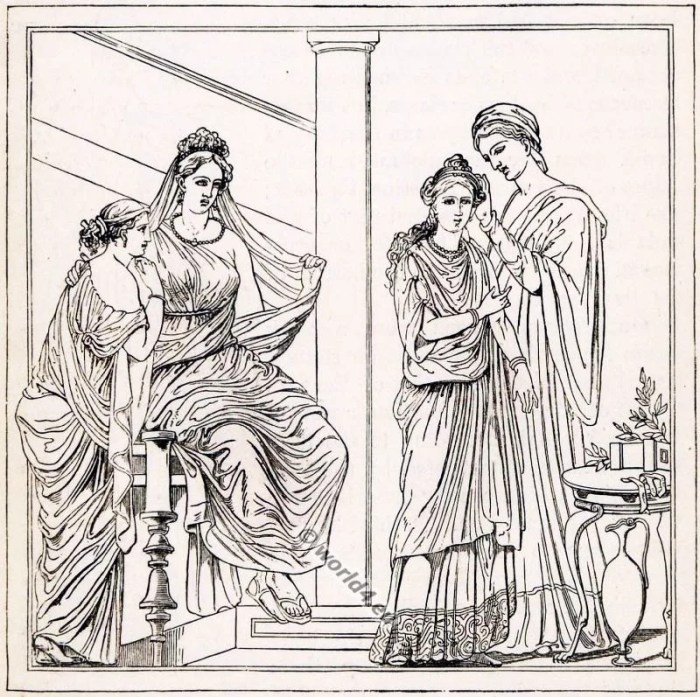The Evolution of Gypsy Wedding Dress Styles: Outrageous Gypsy Wedding Dresses
Outrageous gypsy wedding dresses – Gypsy wedding attire has undergone a fascinating evolution, reflecting both the enduring traditions of various Roma communities and the influence of broader fashion trends. This journey showcases a captivating blend of historical influences, cultural preservation, and modern interpretations.
Historical Influences on Gypsy Wedding Attire
The historical roots of Gypsy wedding dresses are deeply intertwined with the nomadic lifestyle and diverse cultural backgrounds of the Roma people. Traditional designs often incorporated readily available materials and reflected the aesthetics of the regions where specific Roma groups settled. Influences range from the vibrant colors and elaborate embroidery of Eastern European folk costumes to the more understated elegance of certain Western European styles.
The use of specific fabrics and embellishments often held symbolic meanings, passed down through generations.
Transition from Traditional Designs to Modern Interpretations

Source: craiyon.com
While core elements of traditional designs persist, modern interpretations have significantly impacted Gypsy wedding dresses. The increased accessibility of diverse fabrics and embellishments, coupled with the influence of contemporary fashion, has led to a broader range of styles. Many brides now choose to blend traditional elements with modern silhouettes and design aesthetics, creating unique and personalized looks. This fusion maintains a connection to heritage while embracing contemporary fashion sensibilities.
Stylistic Differences Across Gypsy Communities
Significant stylistic variations exist across different Gypsy communities, reflecting their unique histories and cultural practices. For instance, Roma communities in Spain might favor flowing, brightly colored gowns with intricate lace details, while those in Eastern Europe may opt for more heavily embellished dresses with rich embroidery and vibrant patterns. These differences highlight the richness and diversity within the broader Gypsy culture.
Timeline of Key Design Changes
A simplified timeline illustrates key design shifts: Early 20th Century: Primarily regional folk styles; Mid-20th Century: Introduction of more commercially available fabrics and embellishments; Late 20th Century: Increased blending of traditional and contemporary elements; 21st Century: Strong influence of social media and global fashion trends, leading to highly individualized and creative designs.
Key Design Elements of Outrageous Gypsy Wedding Dresses
The term “outrageous” in the context of Gypsy wedding dresses often refers to the lavish use of color, embellishment, and luxurious fabrics. These dresses are a statement of celebration, reflecting the joy and exuberance of the occasion.
Defining Characteristics of “Outrageous” Gypsy Wedding Dresses
Key characteristics include an abundance of vibrant colors, bold patterns, and extensive embellishments. These dresses often feature layers of fabric, creating a dramatic and voluminous silhouette. The overall effect is one of opulence and extravagance, reflecting the importance of the wedding ceremony within the Roma culture.
Use of Vibrant Colors and Bold Patterns
The color palettes are typically bold and vibrant, often featuring rich jewel tones, bright primary colors, and contrasting shades. Patterns are equally striking, ranging from intricate floral motifs to geometric designs and symbolic imagery. These choices contribute significantly to the overall dramatic effect of the dress.
Significance of Embellishments, Outrageous gypsy wedding dresses
Beading, embroidery, and sequins are extensively used, adding layers of texture and visual interest. These embellishments are not merely decorative; they often hold symbolic meaning within specific Roma communities, representing good fortune, prosperity, or protection for the bride.
Comparison of Embellishments and Their Visual Impact
| Embellishment Type | Material | Color Palette | Visual Effect |
|---|---|---|---|
| Beading | Glass, Crystal, Pearls | Varied, often complementing dress color | Adds sparkle, texture, and visual depth |
| Embroidery | Silk, Metallic Threads | Varied, often incorporating symbolic motifs | Creates intricate patterns, adds richness and detail |
| Sequins | Plastic, Glass, Metal | Varied, often used in high-contrast arrangements | Adds sparkle and shine, creates a glamorous effect |
| Lace | Cotton, Silk, Synthetic | Off-white, ivory, or coordinating with dress | Adds delicacy and romanticism, often used in layers |
The Role of Fabrics and Materials
The choice of fabrics plays a crucial role in determining the overall look and feel of a Gypsy wedding dress. Luxurious materials are frequently employed to enhance the sense of opulence and celebration.
Examples of Luxurious Fabrics
Commonly used fabrics include silk, velvet, lace, satin, and brocade. These fabrics offer varying levels of drape, texture, and visual impact, contributing to the overall aesthetic of the dress.
Impact of Fabric Choice on Overall Look
The drape and texture of the fabric significantly influence the silhouette and overall aesthetic. A flowing silk creates a graceful and elegant look, while a heavier velvet adds richness and drama. The choice of fabric is a key consideration in achieving the desired level of opulence and extravagance.
Comparison of Fabric Drape and Texture
Silk is known for its smooth drape and luxurious sheen, while velvet offers a rich texture and plush feel. Lace adds delicacy and intricate detail, while satin provides a smooth, glossy surface. Brocade offers a more structured and ornate look with its woven patterns.
Fabrics in Order of Increasing Opulence

Source: pressablecdn.com
A possible ordering, based on common perception of luxury, could be: Cotton, Satin, Silk, Lace, Velvet, Brocade (this is subjective and can vary based on specific fabric quality and embellishments).
The Significance of Accessories and Headpieces
Accessories and headpieces are integral to the overall presentation of a Gypsy wedding dress, often carrying cultural and symbolic significance.
Descriptions of Typical Accessories
Typical accessories include elaborate jewelry (often featuring gold, precious stones, and intricate designs), ornate veils, and dramatic headpieces. These elements add to the overall richness and extravagance of the bridal attire.
Outrageous Gypsy wedding dresses are known for their vibrant colors and lavish embellishments. A popular element often incorporated into these dramatic designs is a stunning, low back, which sometimes features intricate lace work, similar to the elegance found in a low back lace wedding dress. However, Gypsy wedding dresses typically take this concept to a whole new level of extravagance with added layers of fabrics and bold accessories.
Cultural and Symbolic Meaning of Accessories
The jewelry and headpieces often hold symbolic meaning, representing family heritage, good fortune, or protection for the bride. The veils can symbolize modesty or purity, while the overall ensemble represents the bride’s transition into marriage.
Comparison of Traditional and Modern Accessories

Source: world4.eu
While traditional accessories often feature intricate handcrafted designs and heirloom pieces, modern interpretations may incorporate contemporary materials and designs while retaining the overall sense of opulence and symbolic significance.
Visual Description of a Striking Headpiece
Imagine a headpiece crafted from gold filigree, adorned with shimmering pearls and sparkling crystals. The design incorporates intricate floral motifs, cascading down the back and framing the bride’s face. The color palette is a rich combination of gold, ivory, and clear crystal, creating a breathtaking and regal effect.
The Impact of Modern Trends on Gypsy Wedding Dress Design
Contemporary fashion trends have significantly influenced the evolution of Gypsy wedding dress styles, often leading to innovative and creative designs.
Current Fashion Trends Influencing Gypsy Wedding Styles
Current trends, such as the use of unconventional silhouettes, bold color combinations, and sustainable materials, are increasingly incorporated into Gypsy wedding attire. This reflects a broader shift in fashion towards individuality and self-expression.
Incorporation of Trends into Traditional Designs
Modern trends are often blended seamlessly with traditional elements, creating a unique fusion of old and new. For example, a modern A-line silhouette might be adorned with traditional Gypsy embroidery or a bold color palette might be used in conjunction with classic lace details.
Impact of Social Media on Evolution of Styles
Social media platforms have played a significant role in disseminating new styles and inspiring creativity. Exposure to a wider range of designs and the ability to share personalized creations have accelerated the evolution of Gypsy wedding dress styles.
Adaptation of Modern Silhouettes for Gypsy Attire
Modern silhouettes, such as mermaid gowns, ball gowns, and sheath dresses, are adapted for Gypsy wedding attire by incorporating traditional embellishments, vibrant colors, and luxurious fabrics. This demonstrates the adaptability of traditional designs to contemporary fashion trends.
Regional Variations in Gypsy Wedding Dress Styles
Significant regional variations exist in Gypsy wedding dress styles, reflecting the diverse cultural heritage and geographical distribution of Roma communities.
Distinct Styles Found in Different Gypsy Communities
The styles vary considerably across different regions. For example, Roma communities in Spain might emphasize flowing silhouettes and intricate lace, while those in Hungary might prefer heavily embroidered dresses with bold patterns. These variations highlight the rich tapestry of Gypsy culture.
Comparison of Color, Embellishment, and Silhouette Across Regions
The use of color, embellishment, and silhouette can vary dramatically. Some regions might favor vibrant reds and golds, while others might prefer softer pastels. The level of embellishment also differs, ranging from subtle embroidery to heavily beaded and sequined gowns. Silhouettes can range from flowing and romantic to more structured and fitted.
Unique Regional Traditions Related to Wedding Attire
Many regions have unique traditions related to wedding attire, such as specific headpiece styles, symbolic jewelry, or customary veils. These details add to the cultural richness and individuality of Gypsy wedding ceremonies.
Geographical Map Highlighting Regional Variations
| Region | Dominant Colors | Typical Embellishments | Distinctive Silhouettes |
|---|---|---|---|
| Spain | Reds, Golds, Blacks | Lace, Embroidery | Flowing, Romantic |
| Hungary | Vibrant Jewel Tones | Heavy Embroidery, Beads | Structured, Fitted |
| Romania | Deep Reds, Blues, Greens | Intricate Beadwork, Sequins | Layered, Voluminous |
| England | Variety of Colors, Often Pastels | Lace, Appliqués | Modern Silhouettes with Traditional Details |
FAQ Corner
What are some common fabrics used in outrageous Gypsy wedding dresses?
Luxurious fabrics like silk, velvet, lace, and brocade are frequently used, often layered for added opulence.
How much do these dresses typically cost?
The cost varies greatly depending on the complexity of the design, materials used, and the designer. Prices can range from several hundred to thousands of dollars.
Where can I find a designer who specializes in this style of dress?
Many designers specialize in cultural or ethnic-inspired wedding attire. Searching online for “Gypsy wedding dress designers” or “Bohemian wedding dress designers” will yield relevant results. Local bridal boutiques may also have options or be able to recommend designers.
Are there any specific ethical considerations when purchasing these dresses?
It’s important to ensure that the dress is ethically sourced and made, considering factors like fair labor practices and sustainable materials. Researching the designer and their production methods is recommended.
